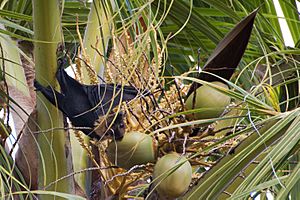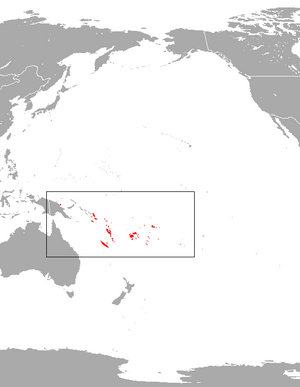Insular flying fox facts for kids
Quick facts for kids Insular flying fox |
|
|---|---|
 |
|
| Conservation status | |
| Scientific classification | |
| Genus: |
Pteropus
|
| Species: |
tonganus
|
 |
|
| Insular flying fox range | |
The insular flying fox or Pacific flying fox (Pteropus tonganus) is a type of flying fox. It belongs to the Pteropodidae family, which includes large bats. This bat lives in many places across the Pacific Ocean. You can find it in American Samoa, the Cook Islands, Fiji, New Caledonia, Niue, Papua New Guinea, Samoa, the Solomon Islands, Tonga, and Vanuatu. In Samoa, people call it pe'a fanua, pe'a fai, and taulaga.
Contents
History of the Insular Flying Fox
In 2006, scientists found old bones of the Pacific flying fox. They were digging at an archaeological site on Rurutu island. This island is in the Austral Islands of French Polynesia. The discovery showed that these bats once lived much farther east than thought.
Scientists used a special method called accelerator mass spectrometry to date the bones. This showed the bat lived between the years 1064 and 1155. The bones were found in very old layers of earth. No bones were found in newer layers. This suggests the bats disappeared from Rurutu a long time ago. It is also possible that humans brought these bats to the island.
What the Insular Flying Fox Looks Like
The insular flying fox has fur that can be different colors. Its back is usually black or a dark brown color. The fur around its neck and shoulders, called the mantle, can be orange, yellow, cream, or tawny.
This bat does not have a membrane between its legs. Its lower arms and lower legs have no fur. Male bats have stiff, short, and oily fur. When these bats fly, their wide wings look like a see-through dark brown color from below.
Where the Insular Flying Fox Lives
The insular flying fox is found in many parts of Polynesia. Its home range includes places like Papua New Guinea, the Solomon Islands, Samoa, and Tonga. It also lives in the Cook Islands, Tuvalu, Tokelau, Niue, Vanuatu, New Caledonia, and Fiji.
These bats sometimes fly between different islands. They like to live in tropical wet forests. You can also find them in mangrove forests and on plantations.
Behavior of the Insular Flying Fox
Like most bats, the insular flying fox is active at night. During the day, they rest in large groups called colonies. They hang high up in the trees. These bats prefer forests in low-lying areas. They also like cliffs, small islands, and swampy places.
Insular flying foxes are frugivores, meaning they eat fruit. They also feed on pollen and nectar from flowers. They are important pollinators for trees like the Ceiba pentandra. They might pollinate other types of plants too.
Reproduction and Life Cycle
Female insular flying foxes usually give birth to one baby each year. Sometimes, they can have twins. The young bats stay with their mothers in the colony.
Status of the Insular Flying Fox
The IUCN checks on animals around the world. They have listed the insular flying fox as "Least Concern". This means it is not currently in danger of disappearing. It lives in many places and is thought to have a large population.
However, these bats face some threats. On some islands, people hunt them for food. Their homes are also being lost. Forests are cut down for logging or to make space for farms. Even though their numbers seem to be going down, it is not fast enough to put them in a more threatened group right now.
See also
 In Spanish: Pteropus tonganus para niños
In Spanish: Pteropus tonganus para niños


